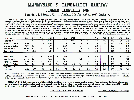 |
Llanmynach & Tawel-llety Railway |
 |
| Timetables & Operation | |
| I have always been interested in the operational capability of the L&TR. This was given a boost by reading 'Model Railroading with John Allen' by Lynn Westcott which has very detailed descriptions on the timetabling and freight car routeing which John employed on his Gorre & Daphetid Railroad.
I had a stab at approximate distances between stations, average speeds and journey times and using these figures produced a number of timetabling diagrams, each one tailored to a particular era of the railway's history. I then set about producing a number of appropriate public timetables for the line, using examples found in various books on the narrow gauge lines as inspiration. I also produced a scheme for routeing the goods vehicles in the same style as John Allen had done. Although I never got around to putting it into practice the need for more goods vehicles to make the scheme work was at least partly responsible for the construction of the fleet of twelve wagons and vans.
Clicking on the thumbnails will open a larger image; use your pc's 'back' button to return to this page. |
|
| Timetables | |
 1875 Timetable© DRB/Buccabury |
The Railway opened as the Sychnant Valley Railway for a sporadic service in July 1875 although an official timetable wasn't published until August of that year. The majority of traffic consisted of untimetabled slate trains and the passenger service was very much a second fiddle. Three return trains were run daily, obviously excluding Sundays, with a journey time of 30 minutes. The timetable gave very basic information only. |
 1882 Timetable© DRB/Buccabury |
By 1882 the line had been open to Tawel-Llety for a couple of years and passenger services were being developed with an eye to the growing Victorian desire for discovering romanticism. Judging by paintings of the period, the Victorians had a peculiar idea that being romantic somehow involved being miles from civilisation, cold, wet and probably suffering from consumption! However, the Railway was happy to oblige and included tourist information on its Summer timetable which advertised seven trains each way per day with services starting from both ends of the line. The journey time between Llanmynach and Mynydd-yn-Bwlch was altered and the total journey time between Llanmynach and Tawel-Llety took one hour in either direction, with a return journey taking 3 hours overall. |
 1921 Timetable© DRB/Buccabury |
The services in 1882 were obviously popular all round as there had been no change by 1921, save for an alteration of style and a revision of the tourist information. |
 1935 Timetable© DRB/Buccabury |
Changing fortunes were apparent by 1935 however, with services reduced to three trains each way daily during the Summer. There was one short working which terminated at Mynydd-yn-Bwlch but which ran only on weekdays. The journey time was given an extra five minutes leeway. |
 1942 Timetable© DRB/Buccabury |
During the War, services were reduced to two trains each way daily although the advertised journey time had reverted to the earlier timing of one hour. |
 1952 Timetable© DRB/Buccabury |
The 1952 Summer timetable displays an enormous change in the Railway's fortunes and the growing trend of touring holidays has encouraged a very ambitious service. There is a return to the halcyon days of the 7 trains each way which had prevailed for many years although Moel Ffynnon is now a request stop only. However, the dwindling demand for slate also allows more latitude and these trains are alternated with six short return workings between Llanmynach and Mynydd-yn-Bwlch which are offered for visitors who don't have the time to complete the full trip. Return journey times vary slightly. The full return trip can be achieved in two and a half hours whilst the 'short return' takes one and a quarter. Back again is the tourist information, completely updated to enable all travellers to enjoy their visit to the Railway and the valleys of the Ffernol and the Sychnant to the fullest extent. |
© 2009 Buccabury or The L&TR General Manager